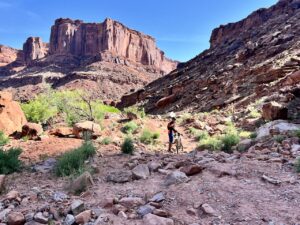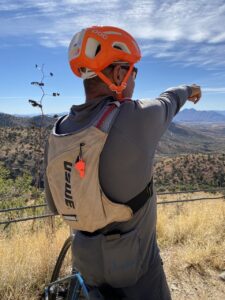We DO NOT provide an overall rating of a route like beginner, intermediate, or advanced. The reason being is that an overall rating is often conflated as a technical difficulty rating or an effort level rating or a combination of the two.
A technical difficulty rating is like you would find on a downhill ski run or mountain bike trail (notice, we did not say route). An effort level rating typically takes into account distance and elevation gain.
At Dirty Freehub, our goal is to get you onto a route that you will enjoy. Thus, we provide a number of different metrics to help you make that decision. Let’s go through these.
Technical Difficulty
 This is our most misunderstood metric, thus why we have put it at the top of the list. This is NOT the effort or physical demand of a route, but rather how skilled you should be with a bike (i.e., bike handing skills) to have a “good” time.
This is our most misunderstood metric, thus why we have put it at the top of the list. This is NOT the effort or physical demand of a route, but rather how skilled you should be with a bike (i.e., bike handing skills) to have a “good” time.
We address physical demand by providing you with the metrics of distance and elevation gain. We also provide an elevation profile that you can cursor along to find the instantaneous gradients.
Technical Difficulty can range from easier to advanced with two intermediate metrics of moderate and demanding.
Easier terrain is indicative of county maintained gravel roads with a solid foundation and “true” gravel. Easier routes will rarely have any single-track or double-track trail. The up / down pitches tend to be quite moderate, never over 6%.
Moderate terrain will have up to several of the following elements in play. Up and down pitches in excess of 6% where you need to have good weight distribution over the bike. Ascending and descending can become a bit trickier; a back wheel may slip out more on the uphill, a front tire may have a tendency to wash-out around a downward corner. Moderate (technical difficulty) routes could also have easier single-track or double-track trail.
Demanding terrain will have several more technical elements in play such as gradients in excess of 12%, mountain bike intermediate single-track trail, washouts, rock chunks larger than gravel, etc. Most skilled mountain bikers and cyclocross riders will find this terrain rideable without dismounting.
Advanced terrain will test the technical limits of most riders. Expect to get off your bike and hike-a-bike a bit. Terrain could be a rocky, gnarly descent at 15% sustained for a mile. It could be a loose climbing pitch at 20% for 0.5 miles. With advanced terrain, most people would feel more comfortable on at least a hard-tail mountain bike or an aggressive adventure gravel bike with 2.1” tires and maybe even front suspension. This is almost mountain biking, but it isn’t.
Distance
The total distance of the route.
Elevation Gain
The total elevation gain for the route. For routes that start and finish at the same spot the elevation gain will be the same as elevation loss. However, for point-to-point routes make sure you look at the elevation gain and elevation loss, they will most likely not the be the same. A 40 mile point-to-point route with 3000 feet of gain and 1000 feet of loss will feel quite different from a route with 1000 feet of gain and 3000 feet of loss.
Locale
This is a metric that provides an indication of how remote a route is. We use urban, urban backcountry, rural, remote, and very remote. An urban gravel route is within city limits and includes a lot of gravel bike path. Urban backcountry is usually a forested or natural setting just on the edge of city limits. Rural is usually county maintained gravel roads that are used for agriculture, farming, and ranch access. In these first three cases you can expect some vehicle traffic and mixed use of trails and paths.
Remote routes are usually within national forests or on BLM lands. The “road” quality can vary from maintained gravel roads to primitive dirt roads. You may or may not have cell phone access and you may or may not encounter others. If you have a mechanical or medical situation, your first and often best resource is your riding team. On these routes we carry personal rescue beacons like a Garmin inReach device or Spot.
Very remote routes are those routes that we ride where we often see no one (not a person, not a vehicle, not a building) for the entire day. You do need to be self-reliant for both mechanical and medical issues. Help is usually a long way off. On these routes we carry personal rescue beacons like a Garmin inReach device or Spot. We do not recommend these routes until you are very comfortable with remote routes.
Navigation
 Navigation can be really tricky! We classify navigation as straightforward, attention required, or challenging. A route that is straight-forward is usually a simple out-and-back or a route that is signed. A challenging route is one that can have many turns, a difficult to find path, 5-way or 6-way intersections, and no signage.
Navigation can be really tricky! We classify navigation as straightforward, attention required, or challenging. A route that is straight-forward is usually a simple out-and-back or a route that is signed. A challenging route is one that can have many turns, a difficult to find path, 5-way or 6-way intersections, and no signage.
Challenging to navigate routes can be within urban areas (think many, many turns, not all signed) or in extremely remote forested areas where there are a zillion logging roads with spurs leading in every direction. With routes that are attention required or challenging, we recommend that you keep open the map display on your bike computer as the primary display for the ride. And remember … turn-by-turn direction cues in remote areas NOT reliable. Do not be lulled into the a sense of confidence that your bike computer will alert you to the next turn with an audible turn-by-turn beep.
Before tackling challenging to navigate route in a remote area, we recommend that you practice, practice, practice navigation on a difficult to navigate course in an urban area that you are comfortable with.
Tire Size
This is just our “best guess” of what the average rider will like for a tire width on a particular route. It is a good metric to use in comparing routes. The larger the recommended tire size, the rockier and chunkier the texture of the route or in the desert southwest, the sandier a route. The bigger the tire the more float you will get in sand / washes.
